|
 STEP
1: Define Petrophysical Objectives
STEP
1: Define Petrophysical Objectives
We seldom do petrophysical analysis for its own sake – usually
the results are used as input to some other activity, like a well
completion plan, an economic analysis, or a reservoir description
for a full field simulation study. An organized approach to
managing petrophysical projects is mandatory. Here is Crain's
time-tested procedure.
Clearly
defined petrophysical goals and procedures help assure an efficient,
technically sound result. The primary purpose is to give the petrophysical
team a set of step by step instructions to assist them in project
definition, planning, execution, and quality control. This will
help to reduce errors and duplication of effort, and maximize
project quality. A good plan and procedure keeps expectations
in line with the data type and quality, as well as with budget
and time constraints.
The
petrophysical plan also helps to acquaint management, the client,
and other groups who rely on the petrophysical results, with our
methods and data requirements. Since integration of petrophysical
data with larger projects is one of the important goals, guidelines
on how to handle these relationships are described here.
Petrophysics
is often a step by step procedural process. However, a number
of motherhood statements are understood to be included (eg. thoroughness,
diligence, persistence, quality, resources). Although we all know
that these factors are important, most unhappy clients, blown
budgets, and delayed deadlines are caused by forgetting these
basics.
The
role of project managers and senior managers is also an important
aspect of an integrated project, since their support is crucial
to the success of a project. Inadequate or late disposition of
resources can only be corrected by senior management, no matter
how willing the analytical staff may be.
The
objective of the Petrophysical Phase is to provide an independent
analysis of all producing or prospective reservoir zones seen
in well logs. The project usually requires integration of the
well log analysis with geological, stratigraphic, petrographic,
conventional core, special core, completion, production, and reservoir
engineering data.
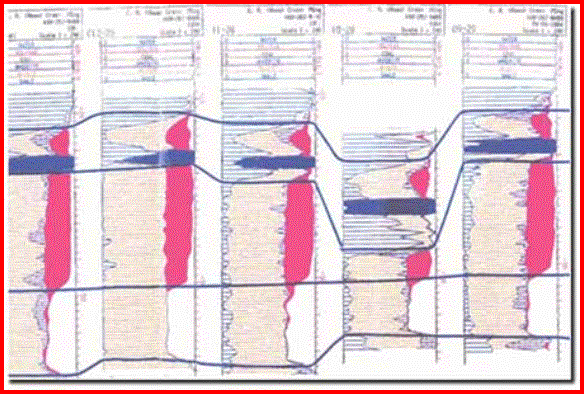
Petrophysical Cross Section From a Forensic Log
Analysis –
Guess Where the Horizontal Well Was Drilled!
 STEP
2: Define Who Does What
STEP
2: Define Who Does What
The petrophysical phase of a project is usually a small to medium
sized portion of a larger project. The usual project phases are:
1.
Geophysical Phase
2. Geological Phase
3. Petrophysical Phase
4. Reservoir Engineering Phase
5. Reservoir Simulation Phase
6. Facilities and Economics Phase
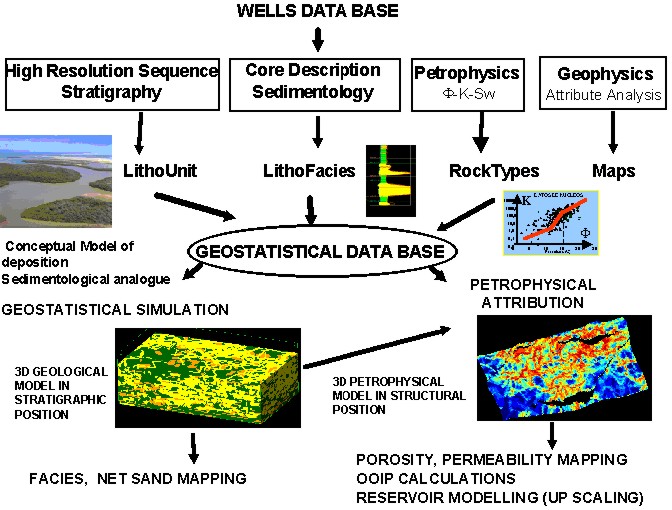
Where petrophysics fits in the
scheme of reservoir description (courtesy of GeoNeurale)
Although
the phases appear to be sequential, there is considerable overlap
and feedback between phases. Careful planning of all phases, and
special attention to the inter-relationships between phases, will
provide the optimum results and minimize costs.
For
example, all Phases require log data, but of different types,
intervals, scales, accuracy, and at different times in the life
of the project. A decision has to be made as to who does the digitizing,
who checks it, and is it done once for all to use, or done as
needed by each group?
Similarly,
Petrophysics requires core porosity vs permeability transforms
and capillary pressure water saturation vs porosity relationships
at an early stage; reservoir engineering needs this data much
later. Should reservoir engineers provide this data to the log
analysts, or vice versa?
The
same questions must be answered with respect to petrographic data,
fluid properties and contacts, geological structure, and other
reservoir description data. All of this data is required by more
than one of the Phases, but at different times.
Once
decisions are made as to who does what, the project manager, and
phase managers, must follow up to be sure the various tasks are
being accomplished correctly and on time, and what other resources
might be needed to help finish.
 STEP
3: Plan the Project Integration
STEP
3: Plan the Project Integration
Integrated planning will coordinate the tasks of all phases of
the project. Critical path timing can be displayed on PERT charts,
as below, or a simple whiteboard, or a spreadsheet such as Excel or
Lotus 1-2-3. The three illustrations below are from an article in
AAPG Geobyte Magazine (199?) by Robert Elphick, my good friend
and long-time editor of Geobyte.
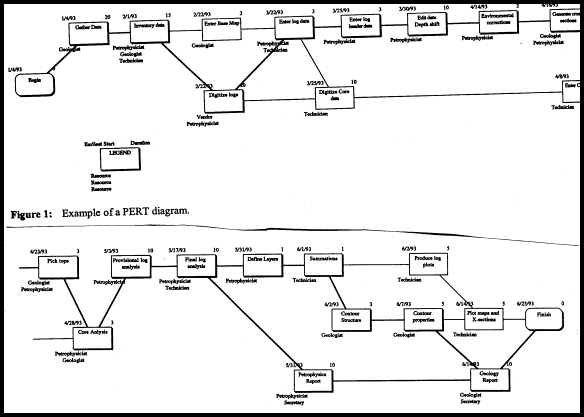
PERT Chart for Petrophysical Project
Better
definition of resource needs and resource conflicts can be seen
on Gantt charts.
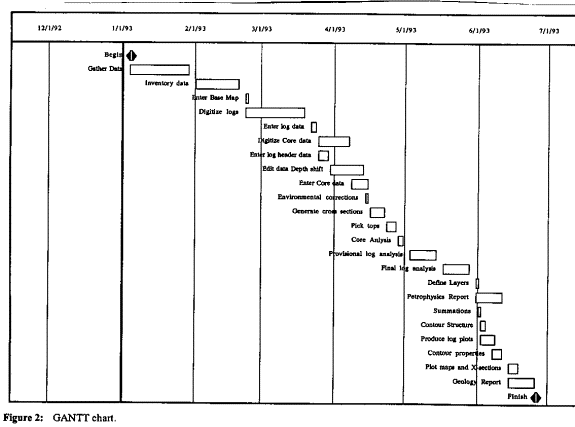
GANTT Chart for Petrophysical Project
Problems show up even more clearly on a Resource Gantt chart.

Resource GANTT Chart for Petrophysical Project
Although
easy to make, these charts require constant updating, usually
weekly. However, the effort is rewarded by catching resource deficiencies
or conflicts before they proceed too far. The three illustrations
shown above are from an article by my good friend Robert Elphick,
published in SPWLA Log Analyst, Dec 1992.
Additional
entries on the Resource Gantt chart are helpful. For example,
showing the timing of all inputs (source data) and outputs (deliverables)
for a resource will show up conflicts that are not apparent in
the resource allocation bars. The output of one Phase is often
the input to another Phase. Assigning people to a Phase when their
inputs are not available produces nothing but frustration.
While
resources may need re-allocation to overcome some obstacles, this
may incur some penalty due to broken continuity or loss of man-power.
Adding people to a team has diminishing returns, which set in
when a team exceeds 6 or 7 people. Conversely, adding or speeding
up hardware and software usually has immediate, low-cost benefits,
provided of course that these resources are truly tested and ready
for release in a real-world environment.
Regular
meetings of all Phase leaders are needed to keep the various activities
coordinated. These should be short, have an agenda distributed
in advance, and be adjourned promptly when the agenda is exhausted.
Smaller meetings may follow to correct specific problems, but
not all Phase leaders need to be present. If a Phase has a number
of staff, Phase meetings may be needed to assemble progress data
before the formal weekly meetings. Brief written weekly and monthly
progress reports should be distributed to Phase leaders and the
client.
 STEP
4: Define the Petrophysical Deliverables
STEP
4: Define the Petrophysical Deliverables
The petrophysical team assists in data gathering, to ensure that
all required data is available at an early stage in the project.
Open
hole logs will be used to determine shale volume, effective porosity,
water saturation, permeability, and (where possible) lithology.
Cased hole log analysis will be performed, as needed, to assist
in determining production characteristics, fluid movements, and
dated fluid contacts. Swept zones, sweep efficiency, and residual
oil saturation in partially depleted reservoirs can often be determined
from modern open and cased hole logs.
Results
will consist of summary tables of pore volume, hydrocarbon pore
volume, flow capacity, average porosity, average water saturation,
average permeability, and net pay after application of cutoffs
and layer depth criteria.
These
results will be used to generate reservoir property maps for estimation
of original oil in place and flow capacity. The maps will be supported
by detailed depth plots and listings of all input and computed
data. Results will be used as input to the Reservoir Engineering
and Reservoir Simulation Phases of the project, and also to assist
in final assessment of mapping performed in the Geological Phase.
Reservoir
zonation is often determined in the Geological Phase, in which
formation tops, stratigraphy, facies, structure, and isopach maps
will be prepared for use in the Petrophysical Phase. Mapping of
petrophysical results and determination of volumetric original
oil in place is usually done as part of the Reservoir Engineering
Phase, but may be delegated to the Geological or Petrophysical
Group.
 STEP
5: Define the Resources Required
STEP
5: Define the Resources Required
A technically and economically successful petrophysical analysis
of a large number of wells in any project requires appropriate
application of the following resources:
1.
a petrophysical manager/analyst.
2. one or more trained log analysts.
3. one or more trained log technicians.
4. dedicated computer hardware for each analyst and technician,
capable of fast
processing and plotting.
5. computer software capable of fast, error free computation.
6. trained digitizing staff with digitizing tables and software.
7. a client who can gain access to the required data and deliver
it in a timely manner
8. a work environment that keeps the team intact for the duration
of the project, and in close proximity to each other.
9. sufficient time to perform all data gathering, database building,
data quality control, technical research, data processing, result
verification, data presentation, and reporting
10. a detailed plan that shows all the steps required for completion
and quality control of the above tasks.
11. close integration with other Phases of the project to minimize
duplication of effort and maximize quality of results for the
client.
12. a corporate infrastructure that will quickly rectify any deficiencies
in the application of needed resources.
It
is common to see Resources #1, 2, and 3 combined in one human
brain/body. If timing constraints do not interfere, this approach
gives good results.
Digitizing
(Resource #6) is often done better by the log analysis technician
(Resource #3) because he/she has a vested interest in the quality
of the work. Another option is an out-of-house service bureau
whose primary business is digitizing logs. Quality control of
this function is critical, as all Phases of the project depend
on a clean, complete, correct database.
Resources
#11 and #12 are also important concerns and control time and budget
over-runs as much as the individual actions of the Petrophysical
Team.
 STEP
6: Define the Data Gathering Process
STEP
6: Define the Data Gathering Process
Petrophysical data gathering is usually done as part of a team
made up of personnel from several Phases, with a qualified log
analyst as a member of the team. Sometimes, data gathering and
inventory is done by a team from only one of the Phases. These
people must be aware of all the data needed for the entire project,
including petrophysics broad needs, not just those of their own
Phase. To minimize effort later, data gathering must be done thoroughly
and inventoried accurately.
If
data is known or suspected to exist, it must be pursued diligently
and persistently until all avenues are exhausted. If required
data is truly not available, the client should be notified of
the consequences immediately, along with a recommendation for
additional work required to overcome the deficiency. For petrophysics,
the missing data is often the electrical properties, petrographics,
mineralogy, water chemistry/salinity, and core porosity-permeability-grain
density data we need to calibrate the log analysis.
The
cooperation of the client in data gathering is critical. Data
that is overlooked or deliberately held back reduces the quality
of the results, to the detriment of the project and everyone involved
in it, including the client representatives. A copy of the data
inventories should be given to the client, with a request to review
and augment the database where possible.
A
complete list of data required for petrophysics is listed below.
Much of the data listed is needed by more than one Phase. However,
each Phase should prepare its own data gathering list, so that
all required data is properly itemized. The combined data gathering
list should be provided to the client before the data gathering
trip to acquaint them with our needs and expedite the gathering
process.
To
obtain optimum results, the petrophysical team requires all pertinent
well data in a timely manner. If some requested data is not available
or arrives late, it may not be possible to calibrate petrophysical
results adequately. In such cases, a discussion of the data deficiencies
will form part of the final report.
Crain’s Data Gathering Checklist
Project
Definition To Be Provided By Client
-
Names and titles of client's key personnel
-
Brief overview of petrophysical requirements and problems
-
List of pools to be analyzed, brief geological description,
brief production history, fluid types, water problems,
special considerations for each pool
-
List of wells, zones, and intervals to be analyzed
-
List of cored intervals, footage recovered, formations
encountered, interval analyzed, special core analysis
intervals, type of special analysis
-
List of logs available and intervals covered
-
List of XY coordinates and KB elevations, with base
map
-
List of log curves and intervals digitized by client
-
List of log curves and intervals to be digitized by
consultant
-
List of wells that require TVD correction
-
List of workovers in each well, with perf intervals,
date, test and IP results
-
List of formation tops in each well
-
Sample well logs and core data from a cored producing
zone
-
If project definition cannot be supplied by the client
we will do this work BEFORE a final proposal and budget
is madeGeology
Data To Be Provided By Client
-
Technical reports and papers on depositional environment,
structural geology, and petrography
-
Geological cross-sections and stratigraphic correlation
chart, formation descriptions
-
Structure map with well locations, faults, fluid contacts
-
Existing porosity, saturation, net pay, permeability,
pore volume, hydrocarbon pore volume, and flow capacity
maps
-
If cross-section and structure map do not exist, they
will be provided by Geological Phase BEFORE Petrophysical
Phase begins.
Petrophysical
Data To Be Provided By Client
-
Sample description (lithology) logs and mud logs
-
Core description
-
Conventional and special core analysis listings
-
Capillary pressure plots and listings
-
Electrical properties plots and listings (Formation
Factor, A, M, N)
-
Formation water chemistry analyses and resistivity
data
-
Formation temperature vs depth data.
-
Well logs - all porosity, lithology, resistivity,
and production logs, paper copies required
-
Deviation surveys or TVD listings
-
All above data on digital tape or disc, as well as
paper, where possible
-
Petrographic, thin section, SEM, and XRD data
-
Previous reports outlining net pay, water saturation,
porosity, net pay cutoffs, etc
-
Any permeability vs porosity transforms previously
used
-
Any A, M, N transforms and RW data previously used
Drilling/Completion/Testing
Data To Be Provided By Client
- Well ticket data
- Legal name and location
- Casing run, depths, type and weight, amount and
type of cement
- Spud and rig release dates
- Formation top names, and depths
- Perforated intervals, type, spacing, and dates
- Cored intervals, type, size, recovery and dates
- Oil analyses, gravity, and GOR
- Gas analyses, composition, and density
- Original and secondary oil/water, gas/oil contacts
- Completion and workover history
- DST tests, intervals, and results
- RFT tests, intervals, and results
- Perf tests, intervals and results
- Deliverability tests, eg: AOF (gas) and IPR (oil)
- Any special drilling problems: blow-outs, lost circulation
zones, stuck in hole, fractures, over pressure
- Treatment and stimulation history
- Production history plots, including monthly oil,
gas, water, and condensate production
- Injected volumes of gas and/or water used for disposal
or enhanced recovery
- List of accepted formation temperatures
|
|
 STEP
7: Build a Clean Database
STEP
7: Build a Clean Database
Preparation of the digital log database is usually the responsibility
of the Petrophysical Team. The requirements of other Phases of
the project must be made known at an early stage so that appropriate
curves and intervals are digitized for all potential uses. An
inventory of hardcopy logs, digitized curves, and intervals will
be maintained by Petrophysics.
If
other Phases prepare log digits for their own use, they should
coordinate their efforts with Petrophysics to minimize duplication.
The
digital log database must reside on one computer under the control
of the Petrophysical Team. This database is termed the Master
Petrophysical Database and cannot be removed or modified except
by authorization of the Petrophysical Manager. It will be backed
up on a weekly basis for safety, with a copy held off premises.
The
integrity of the Master Petrophysical Database is a critical function,
and is the responsibility of ALL petrophysical staff. Problems
or deficiencies in data or procedures should be reported immediately
to the Petrophysical Manager.
Copies
of the Master database may be distributed to other computers or
workstations. However, this data becomes the responsibility of
the users on those workstations. At least one copy of the data
should be in read-only files on the workstation so that users
cannot corrupt the files accidentally. Users may copy these files
to their own directories for their own use. If accidents occur,
the data can be revived from the read-only files.
If
a distributed copy is in use, it is the responsibility of the
user to request updates and to report problems to the Petrophysical
Manager. However, users have a responsibility to make every effort
FIRST to confirm and define the problem by comparing their data
with the read-only files and the hardcopy logs.
Log
data quality control will be undertaken by the Petrophysical Team
as the database is being prepared. If problems are identified
to be caused by inadequate in-house digitizing, further training
will be implemented. Service bureau digitizing will be rejected
if errors are not corrected quickly.
 STEP
8: Quality Control the Digital
Database
STEP
8: Quality Control the Digital
Database
Quality control will consist of the following procedures:
1.
If data is provided in digital form, load and print catalog of
all known data files and compare to data inventory. If data is
digitized in-house, proceed as detailed below.
2.
Plot raw data from top to bottom at 1:xxx scale.
3.
Inventory curves on data plot and depth interval covered by each
curve.
4.
Compare curves and intervals to inventory of open hole logs, and
itemize missing curves or intervals.
5.
Compare plotted curves to original logs, and list curves and intervals
that need to be re-digitized.
6.
Initiate (re)digitizing requests.
7.
Re-plot and recheck new digits.
8.
Update data
 STEP
9: Execute the Petrophysical Plan
STEP
9: Execute the Petrophysical Plan
Petrophysical analysis will proceed on a pool by pool basis. The
method employed for most studies will involve the following steps,
which may vary depending on available data and project objectives.
1.
Gather and inventory available data, review well files, sample
descriptions, drilling history, drill stem and production tests,
completion and production history, and current status of each
well, based on information in the well history files provided
by the client.
2.
Review conventional and special core analysis data and core description
on the cored wells, and enter all data into database. View available
cores and describe fracture patterns and lithology. Initiate and
monitor further core analysis if required.
3.
Prepare core porosity vs core permeability, and vertical vs horizontal
permeability crossplots (by zone by well and by zone all wells)
and determine best fit equations for each zone. Revise transforms
after water saturation data has been calculated and calibrated
to capillary pressure data.
4.
Crossplot porosity vs formation factor and saturation vs resistivity
index from special core data, by zone by well, and by zone all
wells combined. Determine appropriate electrical properties (A, M, and
N) values from available special core studies, from modern EPT/MSFL
logs, and/or from Pickett plots if suitable water zones exist.
5.
Prepare log database and print inventory of available logs by
reading digital data (provided by the client) over required intervals,
digitizing any missing curves or logs according to accepted log
digitizing specifications. CHECK INVENTORY AGAINST HARD COPY LOG
HEADINGS.
The
curve complement will vary with the age of the logs, but will
include deep and shallow resistivity, sonic, neutron, density,
SP, gamma ray, photoelectric, and thermal decay time where available.
Additional curves will be added as needed and where available.
Old style neutron logs will be converted to a porosity scale.
All data will be decimated to 1 foot or 0.3 meter increment.
6.
Plot all raw data and core data vs depth. Compare to original
logs to verify scales, data quality, depth matching, and missing
data. THIS IS AN ABSOLUTELY ESSENTIAL QUALITY CONTROL STEP AND
MUST NOT BE OMITTED.
7.
Prepare initial log analysis and representative crossplots on
cored intervals on key wells with modern log suites to calibrate
porosity and permeability parameters, using the density-neutron-PE
shale corrected complex lithology three mineral model for both
shaly sands and carbonates. Shale volume will be determined from
SP, GR, and density neutron crossplot (some methods are not appropriate
in some zones). Only those crossplots that are necessary for choosing
parameters will be made, but not all will be presented to the
client.
8.
Select appropriate water resistivity and mud filtrate value for
each zone and select appropriate calculation method for original
reservoir and invaded zone water saturation.
9.
Determine effect of conductive non-clay minerals and adjust saturation
accordingly.
10.
Adjust parameters as required and calculate final log analysis
on cored wells, to obtain a good match to core data.
11.
Calculate log analysis on remaining wells with density-neutron-PE
data, but no core data.
12.
When no PE is available, a 2 mineral model will be used. For old
style neutron cases, lithology will be assumed using log analysis
on offset wells or sample description for control.
13.
Calculate log analysis using the shale corrected sonic log model
for wells with core and/or density neutron data, to calibrate
sonic parameters.
14.
Calculate log analysis on remaining wells which have only sonic
log data.
15.
Perform similar steps for wells with density only or neutron only,
calibrating to core or offset density neutron or sonic data.
16.
Demonstrate calibration of log analysis porosity to core porosity
using depth plots, crossplots, and/or regression analysis.
17.
For wells with ancient logs, determine approximate porosity from
porosity mapping of offset wells, to aid in determining net pay
in these wells.
18.
Determine secondary porosity, fracture location and fracture intensity
from all available methods.
19.
After a few of each log suite are analyzed, write preliminary
report and review preliminary results with client, geology team,
engineering team, and compare to geological cross sections and
zoning concepts, as well as reservoir engineering results.
20.
Revise any methods or parameters and analyze remaining wells.
21.
Prepare cross sections to include all wells and compare shale,
porosity, lithology, saturation, permeability, and fluid contacts
from well to well. Check for consistency, geological variations,
data errors, and analysis errors using Quality Control Checklist.
22.
Compare results to geological zoning and run final layer summaries.
23.
Calculate dated water saturation from thermal decay time log where
available, and compare to original water saturation from resistivity
logs.
24.
Determine and justify (if possible) shale, porosity, permeability,
and water saturation cutoffs by comparing log analysis results
to core data, production, and test data.
25.
Determine original and dated gas/oil and oil/water contacts to
define gross intervals, checking with production and test data,
properly adjusted for capillary pressure data and age of well.
26.
Correlate capillary pressure curves and log analysis saturations
over transition zones.
27.
Calculate and print average porosity, average saturation, pore
volume, hydrocarbon pore volume, flow capacity, and productivity
summaries for each layer in each zone for mapping of reservoir
properties.
28.
Prepare depth plots of raw data and answers for wells with any
useable log curves and results at scales of 1:200 and 1:500, for
correlation and mapping purposes, showing formation analysis results,
core analysis porosity and permeability (where available), flags
for bad hole, light hydrocarbons, and pay intervals, and other
requested curves.
29.
Annotate tops, tests, cores, perfs, and fluid contacts on depth
plots. Add annotation tail with this data, parameters used, and
pay zone summaries.
30.
Print detail listings of all requested results for all zones.
31.
Present copies of necessary crossplots for each zone, with discussion
and explanation.
32.
Write final report, documenting calculation methods, parameter
selection, results, and conclusions, and discuss results with
client.
33.
Prepare copies of IBM compatible data tapes or discs in LIS or
LAS format containing raw data and results.
34.
Provide copies of results to other Phases as required through
the duration of the project.
 STEP
10: Check the Petrophysical Results
STEP
10: Check the Petrophysical Results
Quality control of log analysis results derived from visual observations,
chart book methods, programmable calculators, or sophisticated
computer programs, require careful consideration of many factors,
such as:
1.
Sample description, including hydrocarbon shows, porosity indications,
fractures, lithology, and gas kicks.
2.
Hole mechanics, including size, shape, roughness, solution, caving,
casing, and mud type, weight and salinity.
3.
Drill stem test results, including recovery amount and type, flowing
pressures, formation pressure, and mechanical details.
4.
Core data, including porosity, permeability, grain density, lithology
description and saturation.
5.
Production data, including fluid type and amounts, and mechanical
details.
6.
Offset data, including log values, interpretation parameters,
results, and of course, all the above mentioned items on the offset
wells.
7.
The assumptions you made concerning interpretation parameters
and analysis methods.
in
a good analysis, all these factors should corroborate each other.
If they do not, you are missing something or some of your data
is WRONG.
Do
not believe every core, DST, or perf test. They may not be from
the zone they are supposed to be evaluating.
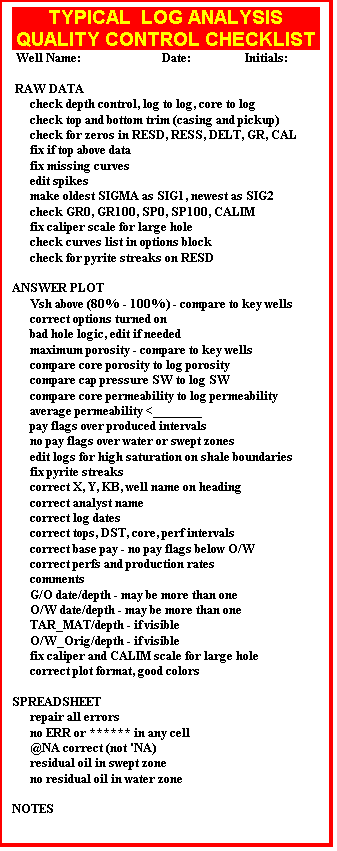 Many
cores range from one to fifteen meters off depth compared to logs.
Since this can usually be identified by the core gamma ray log
or the shape of the porosity distribution, it can easily be cured. Many
cores range from one to fifteen meters off depth compared to logs.
Since this can usually be identified by the core gamma ray log
or the shape of the porosity distribution, it can easily be cured.
However,
DST data does not have any method of correlation, and we must
presume the same frequency and amount of depth adjustment as core
data is needed. Therefore DST's are often off depth compared to
logs.
Perf
tests can be located correctly, because there is usually a correlation
log, but they may produce from elsewhere in the hole due to mechanical
problems, such as channels in the cement, holes in the casing,
tubing or liners, or bad bottom plugs.
Many
cased hole logs may be run to confirm or discount mechanical completion
problems.
A
usual requirement of a log analysis is that it matches core data.
Do not be overly concerned about this, but a reasonable match
is usually possible and expected. The amount of the depth error
may not be clearly discernable by observation of the porosity
curve. The core gamma would be needed to find the correct adjustment.
Variation of one or two percent porosity is common and acceptable,
with the core usually being high. In unconsolidated sands, the
core can be 5 - 10% porosity too high.
A
second requirement is that hydrocarbons be shown on the analysis
over the interval that tested hydrocarbon, and that water be shown
where the well produced water. This is not easy - and many zones
will show water or hydrocarbons where the DST or perf test does
not, especially in shaly sands. Many water tests are really producing
mud filtrate, so take care to distinguish this possibility.
A
good analysis is one that can be reconciled with the facts, without
involving mystical powers or miracles. Adjustments of analysis
parameters are generally needed if agreement is very poor.
Some
zones just do not look good on logs, yet produce prolific quantities
of oil or gas, such as the Viking in Central Alberta or the Austin
Chalk in the Gulf Coast of the USA.
Residual
hydrocarbon, bitumen, or pyrobitumen and heavy oil can cause many
zones to be apparently attractive on logs yet produce water, filtrate,
or nothing on drill stem tests. Try to identify this potential
problem from sample or core description or by moved hydrocarbon
analysis. A similar problem occurs in tight gas sands, where the
zone truly can produce gas, but the DST recovers mud filtrate
or formation water, but little gas.
The
most common error of all is accepting density log data in rough
or large hole - do not be fooled by this. Use the sonic or the
neutron log corrected for shale to see how valid the density log
data might be. DO NOT USE THE DENSITY LOG IF IT IS INCORRECT!!!
Experience
and common sense are the best quality control. Just because it’s
your play, do not make it look too good just because one log can
be used to document your case (and three others contradict it).
Whether
you do an analysis for yourself, your company, or for hire, the
following proviso should be understood by all parties involved:
DISCLAIMER |
| |
GENERAL
TERMS AND CONDITIONS |
| |
Any
interpretation of logs (whether made directly from
logs or by electronic data processing from actual
or digitized log data or electronically transmitted
log data or otherwise) or any recommendation based
on such interpretations are opinions based upon
inferences from electrical or other measurements
and empirical factors and assumptions, which inferences
are not necessarily infallible, and with respect
to which log analysts may differ. Accordingly, we
do not warrant the accuracy or correctness of any
such interpretation or recommendation. Under no
circumstances should any such interpretation or
recommendation be relied upon as the sole basis
for any production decision. We do not guarantee
results. We make no warranties either express or
implied. Under no circumstances shall we be liable
for consequential damages. |
|
Keep
in mind that most service companies use a clause similar to this
one and you should understand the implications of it before you
start any logging operation at a wellsite.
|

